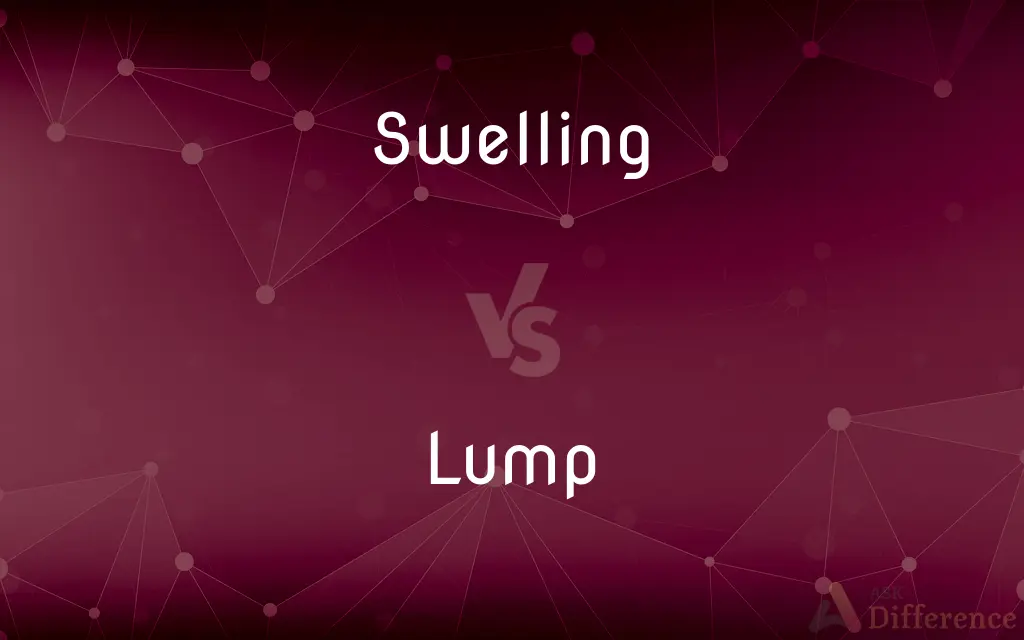Swelling vs. Lump — What's the Difference?
By Tayyaba Rehman & Maham Liaqat — Updated on March 13, 2024
Swelling is a general increase in size or volume, often due to inflammation or fluid accumulation, while a lump is a localized enlargement or mass, usually felt under the skin, which can be caused by various factors including swelling.

Difference Between Swelling and Lump
Table of Contents
ADVERTISEMENT
Key Differences
Swelling is a response to injury, infection, or inflammation, characterized by an increase in size or volume of a body part. It can occur in any body tissue and is often accompanied by redness, heat, and pain. Swelling is a sign of the body's attempt to heal itself, involving the accumulation of fluid in the affected area. On the other hand, a lump is a specific, localized formation that can appear under the skin or within the body. Lumps can result from swelling, but they can also be caused by other factors such as tumors, cysts, or enlarged lymph nodes. While swelling is typically spread over a larger area, lumps are more defined and can be felt as distinct masses.
Swelling can be diffuse, covering a wide area where the boundaries are not easily defined, and it can change locations or sizes relatively quickly, especially in response to treatment or the progression of an underlying condition. Lumps, however, are often more stable in their location and size, and while they may change over time, such changes are usually gradual. Lumps can be benign (non-cancerous) or malignant (cancerous), and their nature often requires evaluation by medical professionals for accurate diagnosis and treatment.
The causes of swelling are varied and can include allergic reactions, infections, injuries, or chronic conditions such as heart failure or kidney disease. The causes of lumps are equally diverse, ranging from benign conditions like lipomas (fatty tumors) or cysts to more serious concerns like cancer. Swelling is generally a temporary condition that resolves with appropriate treatment of the underlying cause, whereas lumps may require specific interventions such as surgery or medication depending on their cause.
Swelling is often treated with rest, ice, compression, and elevation (RICE), especially if caused by injury. Anti-inflammatory medications may also be used to reduce swelling and pain. The treatment for a lump depends on its cause; for example, antibiotics may be prescribed for an infected cyst, while surgical removal may be necessary for tumors. The approach to managing swelling and lumps highlights the importance of understanding their underlying causes for effective treatment.
While swelling and lumps can be related, they represent different medical phenomena. Swelling is a broader reaction to various stimuli, characterized by increased size or volume, whereas lumps are localized formations that arise from a range of conditions, from benign to serious. Proper medical evaluation is crucial for both to ensure appropriate treatment and management.
ADVERTISEMENT
Comparison Chart
Definition
An increase in size or volume, often due to fluid accumulation or inflammation
A localized enlargement or mass, which can be felt under the skin or within the body
Causes
Injury, infection, inflammation, allergic reactions, chronic conditions
Tumors, cysts, swollen lymph nodes, infections, benign or malignant growths
Characteristics
Diffuse, can involve any body tissue, often accompanied by redness, heat, pain
Localized, defined, can be benign or malignant, may not always be accompanied by pain
Treatment
RICE (rest, ice, compression, elevation), anti-inflammatory medications
Depends on the cause: may include antibiotics, surgical removal
Compare with Definitions
Swelling
General increase in size.
The ankle showed swelling after the sprain.
Lump
Localized enlargement or mass.
The doctor examined a lump on the patient's neck.
Swelling
Response to inflammation.
Swelling around the bee sting is a natural inflammatory response.
Lump
Treatment depends on the cause.
The infected lump was treated with antibiotics.
Swelling
Can affect any body part.
Facial swelling can occur due to allergic reactions.
Lump
May require medical evaluation.
Any new lump should be checked by a healthcare professional.
Swelling
Often accompanied by other symptoms.
The swelling was accompanied by pain and redness.
Lump
Can be benign or malignant.
The biopsy confirmed the lump was a benign lipoma.
Swelling
Treated with RICE and medications.
Swelling from the injury was treated with ice and anti-inflammatory drugs.
Lump
Varied causes.
Lumps can form due to infections, cysts, or tumors.
Swelling
The state of being swollen.
Lump
A compact mass of a substance, especially one without a definite or regular shape
There was a lump of ice floating in the milk
Swelling
Something swollen, especially an abnormally swollen body part or area.
Lump
The state of being self-employed and paid without deduction of tax, especially in the building industry
‘Working?’ ‘Only on the lump, here and there’
Lump labour
Swelling
The state of being swollen.
Lump
Put in an indiscriminate mass or group; treat as alike without regard for particulars
Nigel didn't like being lumped in with prisoners
Hong Kong and Bangkok tend to be lumped together in holiday brochures
Swelling
Anything swollen, especially any abnormally swollen part of the body.
Lump
Carry (a heavy load) somewhere with difficulty
The coalman had to lump one-hundredweight sacks right through the house
Swelling
(figurative) A rising, as of passion or anger.
Lump
Accept or tolerate a disagreeable situation whether one likes it or not
You can like it or lump it but I've got to work
Swelling
Present participle of swell
Lump
An irregularly shaped mass or piece.
Swelling
A protuberance; a prominence
The superficies of such plates are not even, but have many cavities and swellings.
Lump
A small cube of sugar.
Swelling
Abnormal protuberance or localized enlargement
Lump
(Medicine) A swelling or small palpable mass.
Swelling
The swelling of certain substances when they are heated (often accompanied by release of water)
Lump
A collection or totality; an aggregate.
Swelling
Becoming puffy as from internal bleeding or accumulation of other fluids;
Put ice on the swelling ankle
Lump
A person regarded as ungainly or dull-witted.
Lump
Severe punishment or treatment, as a beating or an unsparing criticism
Take one's lumps.
Lump
One's just deserts; comeuppance
Get one's lumps.
Lump
Formed into lumps
Lump sugar.
Lump
Not broken or divided into parts
A lump payment.
Lump
To put together in a single group without discrimination.
Lump
To move with heavy clumsiness.
Lump
To make into lumps.
Lump
To become lumpy.
Lump
To move heavily.
Lump
To tolerate (what must be endured)
Like it or lump it.
Lump
Something that protrudes, sticks out, or sticks together; a cluster or blob; a mound or mass of no particular shape.
Stir the gravy until there are no more lumps.
A lump of coal; a lump of clay; a lump of cheese
Lump
A swelling or nodule of tissue under the skin or in an internal part of the body.
Lump
A group, set, or unit.
The money arrived all at once as one big lump sum payment.
Lump
A small, shaped mass of sugar, typically about a teaspoonful.
Do you want one lump or two with your coffee?
Lump
A dull or lazy person.
Don't just sit there like a lump.
Lump
A beating or verbal abuse.
He's taken his lumps over the years.
Lump
A projection beneath the breech end of a gun barrel.
Lump
A kind of fish, the lumpsucker.
Lump
Food given to a tramp to be eaten on the road.
Lump
(transitive) To treat as a single unit; to group together in a casual or chaotic manner (as if forming an ill-defined lump of the items).
People tend to lump turtles and tortoises together, when in fact they are different creatures.
Lump
(transitive) To bear (a heavy or awkward burden); to carry (something unwieldy) from one place to another.
Lump
(transitive) To burden (someone) with an undesired task or responsibility.
Lump
To hit or strike (a person).
Lump
(intransitive) To form a lump or lumps.
Lump
A small mass of matter of irregular shape; an irregular or shapeless mass; as, a lump of coal; a lump of iron ore.
Lump
A mass or aggregation of things.
Lump
A projection beneath the breech end of a gun barrel.
They may buy them in the lump.
Lump
To throw into a mass; to unite in a body or sum without distinction of particulars.
The expenses ought to be lumped together.
Lump
To take in the gross; to speak of collectively.
Not forgetting all others, . . . whom for brevity, but out of no resentment to you, I lump all together.
Lump
To get along with as one can, although displeased; as, if he doesn't like it, he can lump it.
Lump
A large piece of something without definite shape;
A hunk of bread
A lump of coal
Lump
A compact mass;
A ball of mud caught him on the shoulder
Lump
Abnormal protuberance or localized enlargement
Lump
An awkward stupid person
Lump
Put together indiscriminately;
Lump together all the applicants
Lump
Group or chunk together in a certain order or place side by side
Common Curiosities
Can swelling lead to a lump?
Yes, swelling in certain conditions can lead to the formation of a lump, especially if it's due to localized inflammation or a blockage.
What should I do if I find a lump?
If you discover a lump, it's important to have it evaluated by a healthcare professional to determine its cause and appropriate treatment.
How are swelling and lumps diagnosed?
Diagnosis may involve physical examination, medical history, imaging tests like ultrasound or MRI, and sometimes biopsy for lumps.
Can children have swelling or lumps?
Yes, children can experience both swelling and lumps due to various reasons, including infections, injuries, or congenital conditions.
Is swelling always visible?
Swelling is often visible but can also occur internally where it's not directly observable, such as in organs or deep tissues.
How can I tell if a lump is serious?
A lump may be serious if it's hard, immovable, grows over time, or is accompanied by other symptoms like pain. Always consult a doctor for an accurate diagnosis.
Are there self-care measures for lumps?
While some lumps, like simple cysts, may resolve with home care, it's important to first get a proper diagnosis to ensure appropriate management.
What causes swelling in the body?
Swelling can be caused by injury, infection, inflammation, or chronic conditions that affect fluid balance.
Can both swelling and lumps be painful?
Yes, both swelling and lumps can be painful, though painless lumps are also common and warrant medical evaluation.
Why do some lumps move when touched?
Some lumps, like lipomas, are not firmly attached to surrounding tissues and may move slightly when touched, indicating they're likely benign.
Is it normal for swelling to fluctuate?
Yes, the severity of swelling can fluctuate based on the underlying cause and the effectiveness of treatment.
Can diet affect swelling?
Yes, diet can affect swelling, especially foods high in salt can contribute to fluid retention, while anti-inflammatory foods may help reduce swelling.
Share Your Discovery

Previous Comparison
Narrative vs. Recount
Next Comparison
Trapezoid vs. TrapeziumAuthor Spotlight
Written by
Tayyaba RehmanTayyaba Rehman is a distinguished writer, currently serving as a primary contributor to askdifference.com. As a researcher in semantics and etymology, Tayyaba's passion for the complexity of languages and their distinctions has found a perfect home on the platform. Tayyaba delves into the intricacies of language, distinguishing between commonly confused words and phrases, thereby providing clarity for readers worldwide.
Co-written by
Maham Liaqat















































